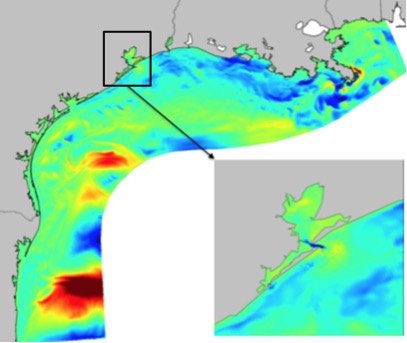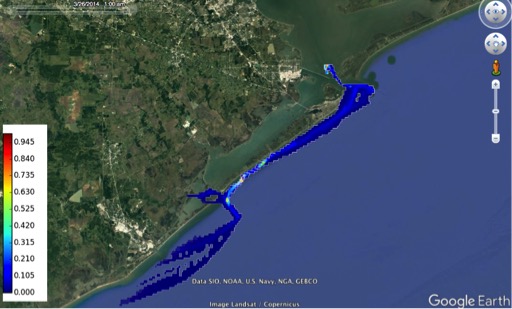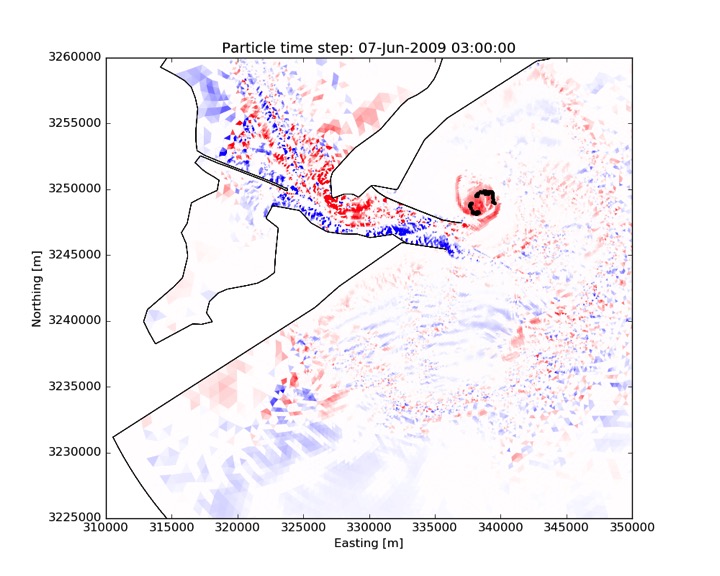 Research Project Full Title: Improving oil spill predictions near shore and across the bay/coastal interface
Research Project Full Title: Improving oil spill predictions near shore and across the bay/coastal interface
Principal Investigator(s): Assoc. Prof. Ben R. Hodges
Researchers:
- Dr. Scott Socolofsky (TAMU),
- Dr. Kristen M Thyng (TAMU),
- Katie Hutschenreuter (TAMU),
- Dr. Xianlong Hou (UT),
- Dongyu Feng
Sponsor(s): Texas General Land Office Oil Spill Prevention & Response Program
 Full Abstract: Where Texas bays meet the alongshore currents of coastal shelf waters, we have an oil spill odeling challenge caused by (i) the scales of tidal eddies at narrow ship channels, (ii) the complexity of nearshore transport paths along the coast, and (iii) the different physical scales of bay and coastal hydrodynamics. Furthermore, the latter point requires different hydrodynamic models for bays and coastal domains, creating a disconnect in oil spill modeling when oil may be transported either into or out of a bay. By improving the models of the GLO oil spill prediction system we can provide a better, more seamless prediction where spilled oil will cross a bay threshold and where it makes landfall along the coast. Because these issues involve both bay and coastal models, along with fundamental problems in fluid mechanics, we have developed an integrated team of three investigators from UT and TAMU who bring different strengths and provide for a closely-coupled project. This project updates and improves oil spill modeling in Texas bays, as well as provides simpler, more reliable techniques for predicting of oils spills that might be ingested into or expelled out of a bay.
Full Abstract: Where Texas bays meet the alongshore currents of coastal shelf waters, we have an oil spill odeling challenge caused by (i) the scales of tidal eddies at narrow ship channels, (ii) the complexity of nearshore transport paths along the coast, and (iii) the different physical scales of bay and coastal hydrodynamics. Furthermore, the latter point requires different hydrodynamic models for bays and coastal domains, creating a disconnect in oil spill modeling when oil may be transported either into or out of a bay. By improving the models of the GLO oil spill prediction system we can provide a better, more seamless prediction where spilled oil will cross a bay threshold and where it makes landfall along the coast. Because these issues involve both bay and coastal models, along with fundamental problems in fluid mechanics, we have developed an integrated team of three investigators from UT and TAMU who bring different strengths and provide for a closely-coupled project. This project updates and improves oil spill modeling in Texas bays, as well as provides simpler, more reliable techniques for predicting of oils spills that might be ingested into or expelled out of a bay.

Additional Links:
Christiansen, D.A. (2013), Flow around a dredge spoil island in a shallow estuary during peak tidal currents, master’s thesis, The University of Texas at Austin, https://repositories.lib.utexas.edu/handle/2152/23641.
Christiansen, D.A., and B.R. Hodges (2016), “Case Study: Near-channel velocities in the presence of a dredge spoil island” ASCE Journal of Waterway, Port, Coastal and Ocean Engineering, 142:2:0501500, 8 pgs. http://dx.doi.org/10.1061/(ASCE)WW.1943-5460.0000311
Hodges, B.R., A. Orfila, J.M. Sayol, and X. Hou (2015) “Operational oil spill modeling: from science to engineering applications in the presence of uncertainty.” In M. Ehrhardt (Editor), Mathematical Modelling and Numerical Simulation of Oil Pollution Problems, The Reacting Atmosphere, Vol. 2, Springer International, Switzerland, pp. 99-126. http://dx.doi.org/10.1007/978-3-319-16459-5.
Hou, X. and B.R. Hodges (2013), Hydrodynamic uncertainty in oil spill modeling, Center for Research in Water Resources, University of Texas at Austin, CRWR Online Report 13-05, 48 pgs., September 2013.
Hou, X. and B.R. Hodges (2014), “Integrating Google Maps/Earth in an automated oil spill forecast system,” Marine Technology Society Journal, 48:4:79-85. http://dx.doi.org/10.4031/MTSJ.48.4.3
Hou, X., B.R. Hodges, S. Negusse and C. Barker (2014), “A multi-model Python wrapper for operational oil spill transport forecasts,” Computational Science & Discovery, 8 0140004, 18 pgs. http://iopscience.iop.org/1749-4699/8/1/014004
Hou, X, and B.R. Hodges (2014), “Visualizing hydrodynamic uncertainty in operational oil spill modeling.” International Oil Spill Conference (IOSC 2014) Proceedings, Vol. 2014, No. 1, pp. 299013, Savannah, GA, May 5-8, 2014. http://dx.doi.org/10.7901/2169-3358-2014-1-299013.1
Hou, X., B.R. Hodges, D. Feng and Q. Liu (2017), “Uncertainty quantification and reliability assessment in operational oil spill forecast modeling system,” 116(1-2): 420-433. http://dx.doi.org/10.1016/j.marpolbul.2017.01.038
Rosenzweig, I., and B.R. Hodges, A Python Wrapper for Coupling Hydrodynamic and Oil Spill Models. Center for Research in Water Resources, University of Texas at Austin, CRWR Online Report 11-09, 48 pgs., October 2011.
